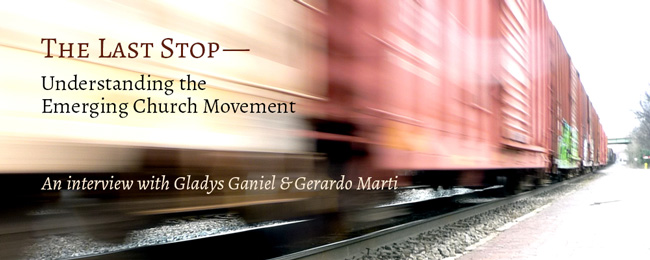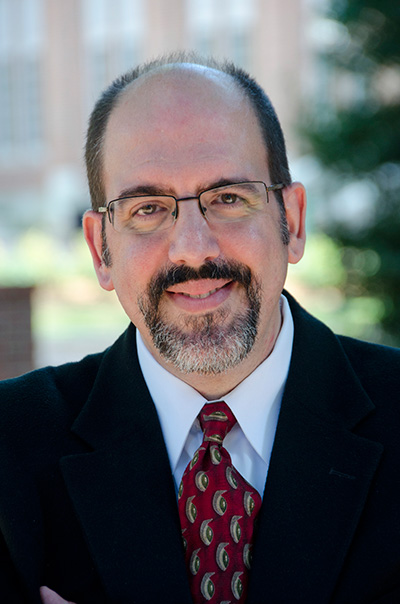An interview with Gladys Ganiel & Gerardo Marti

This article was first published in the Autumn 2013 issue of Bearings, a semi-annual publication of the Collegeville Institute.
Renting space in a historic mainline church in downtown Denver, a motley crew of disaffected evangelicals, gender-bending hipsters, gray-suit executives, philosophical agnostics, recovering addicts, edgy soccer moms, off-the-grid environmentalists, and spiritual seekers of all sorts, gather each week to chant ancient hymns, co-create liturgical art, and celebrate the Eucharist. This unlikely community, known as House for all Sinners and Saints, describes itself as “a group of folks figuring out how to be a liturgical, Christo-centric, social justice oriented, queer inclusive, incarnational, contemplative, irreverent, ancient-future church with a progressive but deeply rooted theological imagination.” House for all Sinners and Saints is affiliated with the Evangelical Lutheran Church in America, but this fact is irrelevant to most of its members, few of whom have a Lutheran background and many of whom have no church background whatsoever. Nadia Bolz-Weber, pastor of House for all Sinners and Saints, breaks as many stereotypes of pastors as House for all Sinners and Saints does of churches. A heavily tattooed smart aleck with a past in addiction and stand-up comedy, Bolz-Weber blogs under the heading “Sarcastic Lutheran: The cranky spirituality of a postmodern gal.” Bolz-Weber and her eclectic congregation might be considered an idiosyncrasy of contemporary religious life were it not for Bolz-Weber’s extraordinary popularity as a writer and speaker, and House for all Sinners and Saints’ growing identity as a destination for religious tourism.
To help us understand the ethos of communities such as House for all Sinners and Saints, as well as their contemporary resonance, Bearings spoke to Gladys Ganiel and Gerardo Marti (read the full article on page 9 of the Autumn 2013 edition), both of whom are preeminent scholars of the movement for which House for all Sinners and Saints has become a flagship: the Emerging Church Movement. Their forthcoming book, The Deconstructed Church: Understanding Emerging Christianity, will be available from Oxford University Press in 2014. Gladys Ganiel is Assistant Professor and Coordinator of the Conflict Resolution and Reconciliation Programme in the Irish School of Ecumenics at Trinity College, Dublin. Gerardo Marti is L. Richardson King Associate Professor of Sociology and Chair of the Sociology Department at Davidson College, Davidson, NC.
How do you introduce the Emerging Church to those who are unfamiliar with the movement?

Gladys Ganiel
Gladys Ganiel (GG): The Emerging Church Movement (ECM) is a reform movement within western Christianity that seeks to overturn what movement members see as conventional and destructive interpretations of the Gospel; to transform religious institutions so they are less hierarchical; and to push Christianity outside the walls of church buildings to serve others in the “real world.” Emerging Christians share a religious orientation that encourages individual autonomy, reflects a deep commitment to interpersonal relationships, and emphasizes innovative practices.
Having said that, we think it can be helpful to introduce the ECM by explaining what it is not. Usually people have heard enough about the ECM to have some misconceptions about it, so we tell them that we don’t see it simply as a reform movement within evangelical Christianity, nor as a re-hashed liberal Protestantism, nor as a pick-and-mix consumerist religion in which people take what they like from various Christian traditions. Frequently the ECM is considered to be merely are-invented evangelicalism. But to focus on its roots in evangelicalism minimizes the resonance that the movement’s message has for mainline and other Christians and for people of non-Christian faiths. The ECM is more than a vaguely defined, fluid, post-church religiosity. Emerging Christians are not disaffected religious “nones.”
Many Emerging Christians have defined the ECM in terms of a “conversation,” signaling that they think Christianity is in need of reform and that one way to reform it is to start talking about the meaning and shape of the Christian faith today. What’s interesting about this conversation is that Emerging Christians see it as an end in itself. The point is not to get to a particular destination; the point is to keep talking, searching, and journeying together.
Why did you choose The Deconstructed Church as the title for your forthcoming book? What is deconstructive about the Emerging Church Movement?

Gerardo Marti
Gerardo Marti (GM): We called the book The Deconstructed Church because we think it captures what Emerging Christians are doing. They are trying to pull apart and critique existing forms of church life. In place of those old forms they are constructing what they see as better ways of living together as Christians. Emerging Christians share a religious orientation built on a continual practice of deconstruction. They actively deconstruct congregational life by questioning the beliefs and practices that have held sway within other expressions of Christianity, especially conservative evangelicalism.
Many Emerging Christians were previously involved in evangelicalism, which they experienced as constraining, prescriptive, captivated by a wrong-headed biblical literalism and a conservative political agenda, or even emotionally abusive. Seeker megachurches, which Emerging Christians see as manipulative, homogenizing, and missing Jesus’ point of identifying with the poor and marginalized, receive some of their harshest criticism. Some Emerging Christians also critique other expressions of Christianity, including forms of liberal Protestantism that they have experienced as “dead,” or a Catholicism they found authoritarian or abusive.
Emerging Christians think that many of the ideas and institutions of contemporary Christianity simply do not help them to live what they would call authentic or holistic Christian lives. They often say that their involvement in an ECM church is the only thing keeping them within the bounds of Christianity at all, describing it as their “last stop” before leaving religion completely.
How has the Emerging Church Movement evolved in the 15 years since the movement began? Some have declared the movement to be dead. You obviously don’t agree. Why not?
GG: The death of the ECM has been greatly exaggerated. We have seen confusion about various terms associated with the ECM, like “emerging,” “emergent,” “emergence,” “post-evangelical,” “missional,” “neo-monastic,” “ancient-future faith,” and so forth. But as our research tells us, people who share Emerging Christians’ religious orientation do not like to be put into identity boxes, or to identify with religious labels. Nor are they particularly concerned with convincing people to join with the ECM as a movement. So rather than announcing the ECM’s death, we see it as moving beyond specific groups, congregations, and collectives that explicitly take on the moniker of “emerging.”
What does the Emerging Church Movement tell us about the contemporary religious landscape? What is its significance as a modern religious movement?
GM: More than many other expressions of contemporary Christianity, the Emerging Church Movement creates spaces where people can exercise their freedom and autonomy to embark on individualizing religious imperatives. The ECM is also more effective than other forms of western Christianity in helping Christians balance the tensions between individualism and communitarianism, tensions that are part and parcel of the modern world.
Emerging Christians strive to achieve authenticity and holism across all areas of their lives. They are modern people who must cope with the demands of simultaneously juggling multiple identities and participating in multiple social structures. The lack of a single, primary “foothold” for personal identity, which the church may have provided for past generations, stimulates the peculiarly reflective nature of modern individuals. People are constantly forced to reflect on and explain their lives to themselves in quest of a meaningful sense of personal coherence. The consequence for religion shouldn’t be understood as an outbreak of syncretism, where people merge quite divergent religious orientations; rather, believers from different backgrounds discover new religious freedoms, change their old religious world views, and develop religious identities that draw on a range of sources.
But the ECM does more than emphasize the individual. It’s also inherently corporate, as reflected in its stress on conversations, relationships, and networks. The pursuit of self-coherence does not mean Emerging Christians aren’t concerned with caring for others and mutual relationships. Individualization is compatible with establishing interpersonal structures of care and concern. The ECM’s deliberately varied, pluralist congregations provide mechanisms for sustaining this delicate balance. Emerging Christians believe they cannot authentically become themselves without being in community with others.
What are your predictions about the face of Christianity over the next decades in light of what you have learned about the Emerging Church? Do you think the Emerging Church Movement will play a role in Christianity’s historical development?
GM: The ECM’s resonance with the wider trends and values of our age leads us to conclude that Emerging Christianity cannot help but persist, even thrive, in the current religious environment. It will contribute to changes in the face of Christianity over the next decades. In the U.K. the term “mixed economy” is often used to describe how emerging congregations and “inherited forms of church”—the Church of England, for example—exist side-by-side. The situation in the U.S. is similar. Emerging and inherited churches are not always on friendly terms, but it’s clear that they are influencing one another, whether through mutual critique or mutual appreciation. Therefore, we don’t measure the ECM’s significance by how many emerging congregations can be counted. The ECM’s significance must be evaluated according to the ways in which Emerging Christians are creating a distinct religious orientation. This religious orientation not only nurtures their own congregations but also contributes to structural and theological changes in long-established religious institutions, including traditional western denominations.
Emerging Christians also do the wider Christian community a favor by pointing out that Christianity is remarkably diverse and contradictory. They look around and have no difficulty finding multiple Christian traditions. A singular, monolithic Christendom is a myth. Christianity is characterized by the simultaneous existence of numerous logics and systems of meaning involving multiplicity and heterogeneity, complementing and competing with each other.
The remarkable pluralism of contemporary society and the need for fragmented individuals to forge a cohesive self means that religious individualization will be a characteristic feature of nearly all forms of Christianity. Yet Christianity remains a congregational religion. No religious self, even a critically oriented religious self, can thrive without a community of others. As one Emerging Christian told us, his congregation is an “open space where individuals get to work out whatever they need. Individuals are coming together.” This pattern in which religious individualism is woven together with pluralist congregations will continue as a ubiquitous element of modern religiosity.
Image: Freight Train by Ted Major, from Flickr Commons
Like this post? Subscribe to have new posts sent to you by email the same day they are posted.



Leave a Reply